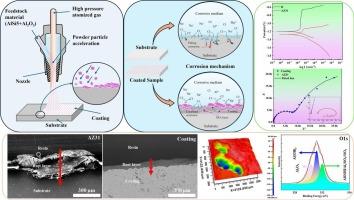Unveiling advanced corrosion resistance of novel Al-5Si/Al2O3 cold spray coatings for enhanced durability of AZ31 magnesium alloy
IF 6.1
2区 材料科学
Q1 MATERIALS SCIENCE, COATINGS & FILMS
引用次数: 0
Abstract
An innovative corrosion-resistant Al-5Si/Al2O3 composite coating was effectively deposited on AZ31 magnesium alloy using the supersonic cold spray technique. The corrosion performance of both coated and uncoated AZ31 samples was systematically evaluated through a 1000-h salt spray test in 5 wt% NaCl and electrochemical methods. Comprehensive morphological and chemical characterizations were conducted using scanning electron microscopy (SEM) with energy-dispersive spectroscopy (EDS), white light interferometry (WLI), X-ray diffraction (XRD), and high-resolution X-ray photoelectron spectroscopy (HR-XPS). The uncoated AZ31 alloy exhibited severe corrosion degradation, characterized by deep pits, microcracks, and a ∼ 4 × times thicker corrosion layer compared to coated samples, primarily attributed to the formation of non-protective MgO/Mg(OH)2 layers and the presence of Mg7Zn3 intermetallic phases. In contrast, the Al-5Si/Al2O3 composite coating demonstrated outstanding corrosion resistance, with minimal surface degradation, a ∼ 3× reduced corrosion depth. Electrochemical measurements revealed a substantial decrease in corrosion rate from 82.51 μm/year (bare AZ31) to 4.17 μm/year (composite-coated AZ31). Unlike conventional Al-based cold spray coatings, this study introduces a dual-phase Al-5Si/Al2O3 composite that promotes the formation of stable Al2O3, and in-situ generated SiO2 passive films, thereby offering superior and long-term corrosion protection in aggressive chloride environments. These findings underscore the efficacy of the composite coating in significantly enhancing the corrosion resistance of AZ31 magnesium alloy.

揭示了新型Al-5Si/Al2O3冷喷涂涂层提高AZ31镁合金耐久性的先进耐腐蚀性
采用超声速冷喷涂技术,在AZ31镁合金表面制备了新型的Al-5Si/Al2O3复合涂层。通过5wt % NaCl的1000 h盐雾试验和电化学方法,系统评价了涂层和未涂层AZ31样品的腐蚀性能。利用扫描电镜(SEM)、能谱(EDS)、白光干涉(WLI)、x射线衍射(XRD)和高分辨率x射线光电子能谱(HR-XPS)对样品进行了全面的形态和化学表征。未涂覆的AZ31合金表现出严重的腐蚀退化,其特征是深坑、微裂纹和比涂覆样品厚4倍的腐蚀层,这主要是由于非保护性MgO/Mg(OH)2层的形成和Mg7Zn3金属间相的存在。相比之下,Al-5Si/Al2O3复合涂层表现出出色的耐腐蚀性,表面降解最小,腐蚀深度降低了3倍。电化学测量表明,腐蚀速率从82.51 μm/年(裸AZ31)大幅降低到4.17 μm/年(复合涂层AZ31)。与传统的铝基冷喷涂涂层不同,该研究引入了一种双相Al-5Si/Al2O3复合材料,可促进稳定Al2O3的形成,并在原位生成SiO2被动膜,从而在腐蚀性氯化物环境中提供卓越的长期防腐保护。结果表明,复合涂层可显著提高AZ31镁合金的耐蚀性。
本文章由计算机程序翻译,如有差异,请以英文原文为准。
求助全文
约1分钟内获得全文
求助全文
来源期刊

Surface & Coatings Technology
工程技术-材料科学:膜
CiteScore
10.00
自引率
11.10%
发文量
921
审稿时长
19 days
期刊介绍:
Surface and Coatings Technology is an international archival journal publishing scientific papers on significant developments in surface and interface engineering to modify and improve the surface properties of materials for protection in demanding contact conditions or aggressive environments, or for enhanced functional performance. Contributions range from original scientific articles concerned with fundamental and applied aspects of research or direct applications of metallic, inorganic, organic and composite coatings, to invited reviews of current technology in specific areas. Papers submitted to this journal are expected to be in line with the following aspects in processes, and properties/performance:
A. Processes: Physical and chemical vapour deposition techniques, thermal and plasma spraying, surface modification by directed energy techniques such as ion, electron and laser beams, thermo-chemical treatment, wet chemical and electrochemical processes such as plating, sol-gel coating, anodization, plasma electrolytic oxidation, etc., but excluding painting.
B. Properties/performance: friction performance, wear resistance (e.g., abrasion, erosion, fretting, etc), corrosion and oxidation resistance, thermal protection, diffusion resistance, hydrophilicity/hydrophobicity, and properties relevant to smart materials behaviour and enhanced multifunctional performance for environmental, energy and medical applications, but excluding device aspects.
 求助内容:
求助内容: 应助结果提醒方式:
应助结果提醒方式:


